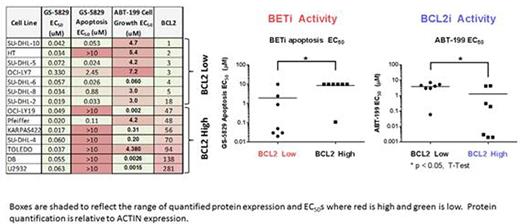Abstract
Introduction: GS-5829 is a potent and selective inhibitor of the bromodomain and extra-terminal (BET) family of proteins. BET proteins regulate the transcription of key oncogenes including MYC, resulting in cancer cell growth (Yang Z. et. al. Mol Cell Biol 2008; LeRoy G. et. al. Mol Cell 2008). Diffuse large B-cell lymphoma (DLBCL) is a diverse and genetically heterogeneous subtype of non-Hodgkin's lymphoma (NHL) (Lenz G. et. al. N Engl J Med 2010). Lymphomas harboring translocation of both MYC and BCL2, the so called "double hit" lymphoma, have a poor prognosis (Li S. et. al. Mod Pathol 2012). High protein expression of MYC and BCL2 together, in the absence of translocation, was also shown to be a poor prognostic indicator for DLBCL patients treated with R-CHOP which consists of rituximab, Cyclophosphamide, Hydroxydaunorubicin, Oncovin (vincristine), and Prednisone (Green T. et. al. J Clin Oncol 2012). Though double hit lymphoma occurs in 5% of DLBCL patients, 29% of DLBCL patients express high levels of both proteins-even in the absence of translocation. ABT-199 is a potent and selective BCL2 inhibitor and sensitivity to ABT-199 in DLBCL cell lines correlates with high basal BCL2 protein expression (Souers A. et. al. Nat Med 2013). We evaluated the combination of GS-5829 and ABT-199 in DLBCL and MCL cell lines in vitro.
Methods: The activity of GS-5829 and ABT-199 alone or in combination in DLBCL and Mantle Cell Lymphoma (MCL) cell lines was assessed by evaluating cell growth inhibition and apoptosis. Growth inhibition was evaluated by CellTiterGlo or ATPLite. Apoptosis was assessed by Annexin V positivity by flow cytometry. The protein levels of MYC, BCL2, BIM, BCL-XL, and MCL1 were quantified by Western blotting and normalized to ACTIN levels. Analyses were performed to determine whether the expression of any of the profiled proteins correlated with the activity of GS-5829 or ABT-199.
Results: DLBCL cell lines were broadly sensitive to cell growth inhibition by GS-5829, with EC50s ranging from 17 to 330 nM. Growth inhibition correlated with the reduction in MYC protein levels upon treatment with GS-5829. Treatment with GS-5829 induced apoptosis in a subset of DLBCL cell lines (58%). Cell lines with low level expression of BCL2 were more sensitive to GS-5829-induced apoptosis (p < 0.05 by T-Test). Expression levels of the other profiled proteins did not correlate with GS-5829 activity. DLBCL cell lines varied in sensitivity to ABT-199, with EC50s ranging from 1.5 to 7200 nM. Cell lines that were sensitive to ABT-199 in general had high levels of BCL2 protein. The single-agent activity of GS-5829 and ABT-199 in DLBCL cell lines had an apparent reciprocal relationship (Figure 1). The combination of GS-5829 and ABT-199 at clinically relevant concentrations resulted in broader activity and greater suppression of cell growth than either agent alone in a panel of DLBCL and MCL cell lines (Figure 2).
Conclusion: The data demonstrated a reciprocal sensitivity of DLBCL cell lines to the BET inhibitor GS-5829 and the BCL2 inhibitor ABT-199. The combination of these two agents resulted in superior growth inhibition in DLBCL and MCL cell lines. These data suggest that GS-5829 and ABT-199 in combination may lead to broader, superior responses in DLBCL and MCL.
Growth Inhibition by ABT-199 and Induction of Apoptosis by GS-5829 are Significantly Different in the High and Low Basal BCL2 Protein Expression Groups.
Growth Inhibition by ABT-199 and Induction of Apoptosis by GS-5829 are Significantly Different in the High and Low Basal BCL2 Protein Expression Groups.
Combination of GS-5829 and ABT-199 Resulted in More Potent Inhibition of Cell Growth in DLBCL Cell Lines at Clinically Relevant Concentrations (42 - 120 nM GS-5829 in Blue and 330 nM ABT-199).
Combination of GS-5829 and ABT-199 Resulted in More Potent Inhibition of Cell Growth in DLBCL Cell Lines at Clinically Relevant Concentrations (42 - 120 nM GS-5829 in Blue and 330 nM ABT-199).
Bates:Gilead Sciences: Employment, Equity Ownership. Kusam:Gilead Sciences: Employment, Equity Ownership. Tannheimer:Gilead Sciences: Employment. Clarke:Gilead Sciences, Inc.: Employment, Equity Ownership. Kenney:Gilead Sciences, Inc.: Employment, Equity Ownership. Breckenridge:Gilead Sciences: Employment, Equity Ownership. Tumas:Gilead Sciences: Employment, Equity Ownership.
Author notes
Asterisk with author names denotes non-ASH members.



